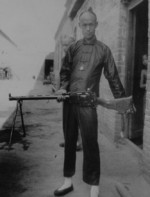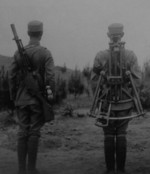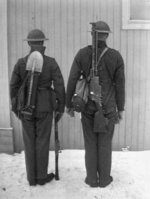Madsen Machine Gun
| Country of Origin | Denmark |
| Type | Machine Gun |
| Caliber | 7.920 mm |
| Length | 1.143 m |
| Barrel Length | 584.000 mm |
| Weight | 9.070 kg |
| Rate of Fire | 450 rounds/min |
| Muzzle Velocity | 870 m/s |
Contributor: C. Peter Chen
ww2dbaseThe Madsen light machine guns were developed by a Captain Vilhelm Herman Oluf Madsen of the Danish artillery in 1896 and were adopted by the Danish Army in 1902. They were among the first true light machine guns produced in quantity. They were made by Compagnie Madsen A/S. The company later operated under the names of Dansk Rekyl Riffel Syndikat A/S and Dansk Industri Syndikat A/S. After Russia purchased 1,250 units, many of them were deployed in the east during the Russo-Japanese War. In 1914, the German Army deployed them and saw service during WW1. Both nations noted that they were expensive but extremely reliable, thus eventually over 34 nations worldwide placed orders between the 1910s and the 1930s, serving in combat in faraway places such as South America and China. By Apr 1940, the Norwegian Army was still using the Madsen light machine gun as its standard light machine gun; 3,500 units of them were in use when Germany invaded Norway. Norwegian and Danish examples captured by the Germans were kept in use in second line units. In the Pacific, the Royal Netherlands East Indies Army operated a number of them, and some were captured and used by the Japanese. After WW2, the Danish Army used them until 1955. During the Portuguese Colonial War of the 1960s and the 1970s, the Portuguese Army used Madsen light machine guns either with light infantry units or mounted on armored cars. Among the last forces to retire these weapons was the Military Police of the state of Rio de Janeiro, Brazil, which used them until Apr 2008.Though listed on here with the caliber 7.92-millimeter, due to the wide market for this weapon design, they were actually of a various number of calibers, using cartridges such as the 7x57mm Mauser, 6.5x55mm, 7.92x57mm Mauser, and others.
Source: Wikipedia. ww2dbase
Last Major Revision: Mar 2009
Photographs
 |  |  |  |
Please consider supporting us on Patreon. Even $1 per month will go a long way! Thank you. Please help us spread the word: Stay updated with WW2DB: |
Visitor Submitted Comments
All visitor submitted comments are opinions of those making the submissions and do not reflect views of WW2DB.
Search WW2DB

News
- » Wreck of Teruzuki Found (27 Jul 2025)
- » USS Orlean's Bow Found (22 Jul 2025)
- » The Emperor of Japan Planned to Honor WW2-era Japanese POWs in Mongolia (4 Jul 2025)
- » US State Lawmaker John Winter Caught Using Racial Slur "Jap" and Apologized (11 Jun 2025)
- » US Government Plans to Purge WW2 Information (17 Mar 2025)
- » See all news
Current Site Statistics
- » 1,182 biographies
- » 337 events
- » 45,119 timeline entries
- » 1,249 ships
- » 350 aircraft models
- » 207 vehicle models
- » 376 weapon models
- » 123 historical documents
- » 261 facilities
- » 470 book reviews
- » 28,415 photos
- » 365 maps
Famous WW2 Quote
"The raising of that flag on Suribachi means a Marine Corps for the next 500 years."James Forrestal, Secretary of the Navy, 23 Feb 1945
Support Us
Please consider supporting us on Patreon. Even $1 a month will go a long way. Thank you!
Or, please support us by purchasing some WW2DB merchandise at TeeSpring, Thank you!
30 Oct 2010 12:09:19 PM
The Madsen Light Machine gun, was not the
weapon I was thinking about that was listed
in the small arms section.
FROM DENMARK:
Madsen introduced in 1946 the M-50/M-53 9mm
Sub-machine gun, the weapon was easy to field-strip the box magazine held 32 rounds
later models had a curved magazine.
It remained in service from the 1950s into
the 1980s.
Brazil manufactured a model chambered in
45 APC.
'Star Trek' fans will remember the episode
called 'Bread and Circuses'. Kirk, Spock and
Dr. McCoy find themselves in 20th Century
Rome, the guards are armed with the Madsen
Sub-machine gun. As they beam back to the
Enterprise, the guards fire at them, using
blanks thus no bullet holes in the cell walls!